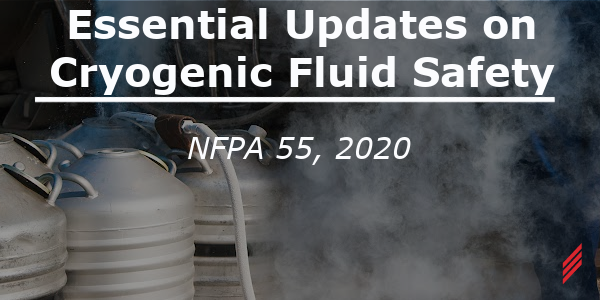Essential Updates on Cryogenic Fluid Safety: NFPA 55, 2020
by Noah Singer on Jul 18, 2024 10:30:00 AM

At Hallam ICS, we pride ourselves on our collective knowledge of all applicable design codes and standards. As codes and standards are updated, we track the changes and discuss implications to projects, clients, and partners. From new refrigerant requirements, to energy code changes, to fire code updates, we are aware of the changes and communicate them to our clients expeditiously. NFPA 55, 2020 contains new language about relief valves on cryogenic liquid delivery systems which must be implemented on new and existing systems.
The Change
Where NFPA 1, 2021 is the prevailing fire code, NFPA 55, 2020 is the applicable compressed gases and cryogenic fluids code. NFPA 55, 2020 became statutory in Massachusetts on December 9, 2022. There is new language in NFPA 55, 2020 relating to pressure relief devices on cryogenic liquid piping systems fed from bulk sources. The code language from NFPA55, 2020 section 8.2.4.1.1 is:
“Where a bulk gas source system is connected to an indoor cryogenic fluid piping system protected by a pressure relief device that is designed to protect against exceeding the maximum allowable working pressure or maximum process operating pressure, releases shall be directed to a safe location outdoors to the open air.”
The underlined section above is an impactful addition in this code version. Previously, relief valves on these systems were allowed to vent inside the buildings in which they reside. However, this arrangement has the potential to inadvertently fill a space with gas from a bulk source creating a hazardous atmosphere. This code update requires relief valve outlets to be piped outside of the building so an interior space is not filled with gas if a relief valve lifts. Existing systems must be modified, and new systems must be designed so their relief valves are vented to the outside of the building.
Who it Affects
This change applies to any facility with a bulk cryogenic source connected to a cryogenic fluid piping system. Hospitals, universities, and manufacturing facilities commonly have such systems for delivering cryogenic liquids where they are needed. Relief valves anywhere on the system must be vented outside.
The Solution
For new systems to be designed and existing systems to be retrofitted, the solution is similar. For existing systems, relief valves with threaded outlets (Exhibit 1) should be specified and installed in place of the relief valves without threaded outlets (Exhibit 2). For new systems, threaded outlet relief valves should be specified and installed anywhere a pressure relief valve is required. The threaded outlets are then headered together into a common vent pipe which is routed to the exterior of the building. It is crucial the vent header piping never be made smaller than the relief valve outlets. In a scenario where a relief valve opens, the gas will flow to the outside of the building and the atmosphere in the room will remain safely breathable. Though it’s a capital expenditure to retrofit an existing cryogenic liquid delivery relief system, overall safety will be increased and the system will be NFPA 55, 2020 compliant. Reach out to Hallam-ICS for a relief system retrofit to increase safety and to maintain code compliance!

About the Author
Noah Singer is a process engineer at Hallam-ICS with experience in utility scale liquified natural gas and large-scale petrochemical processing. He has a B.S. in mechanical engineering from SUNY Binghamton, an M.S. in engineering management from Tufts University and holds professional engineering licenses in MA, RI and PA. Outside of work, Noah can be found mountain biking in New England, skiing in Utah and strolling around nature preserves near Boston.
Read My Hallam Story
About Hallam-ICS
Hallam-ICS is an engineering and automation company that designs MEP systems for facilities and plants, engineers control and automation solutions, and ensures safety and regulatory compliance through arc flash studies, commissioning, and validation. Our offices are located in Massachusetts, Connecticut, New York, Vermont and North Carolina and our projects take us world-wide.
You May Also Like
These Related Stories

Advancing Automation Technology - How to Specify a Domain Controller

Pros and Cons of Different Economizer Configurations for Data Centers



No Comments Yet
Let us know what you think